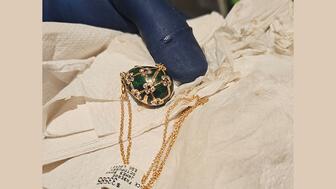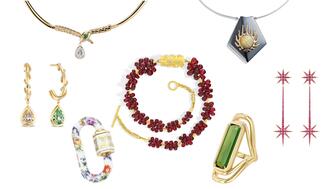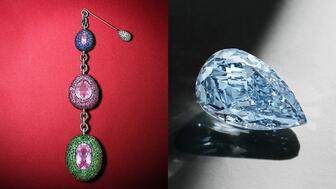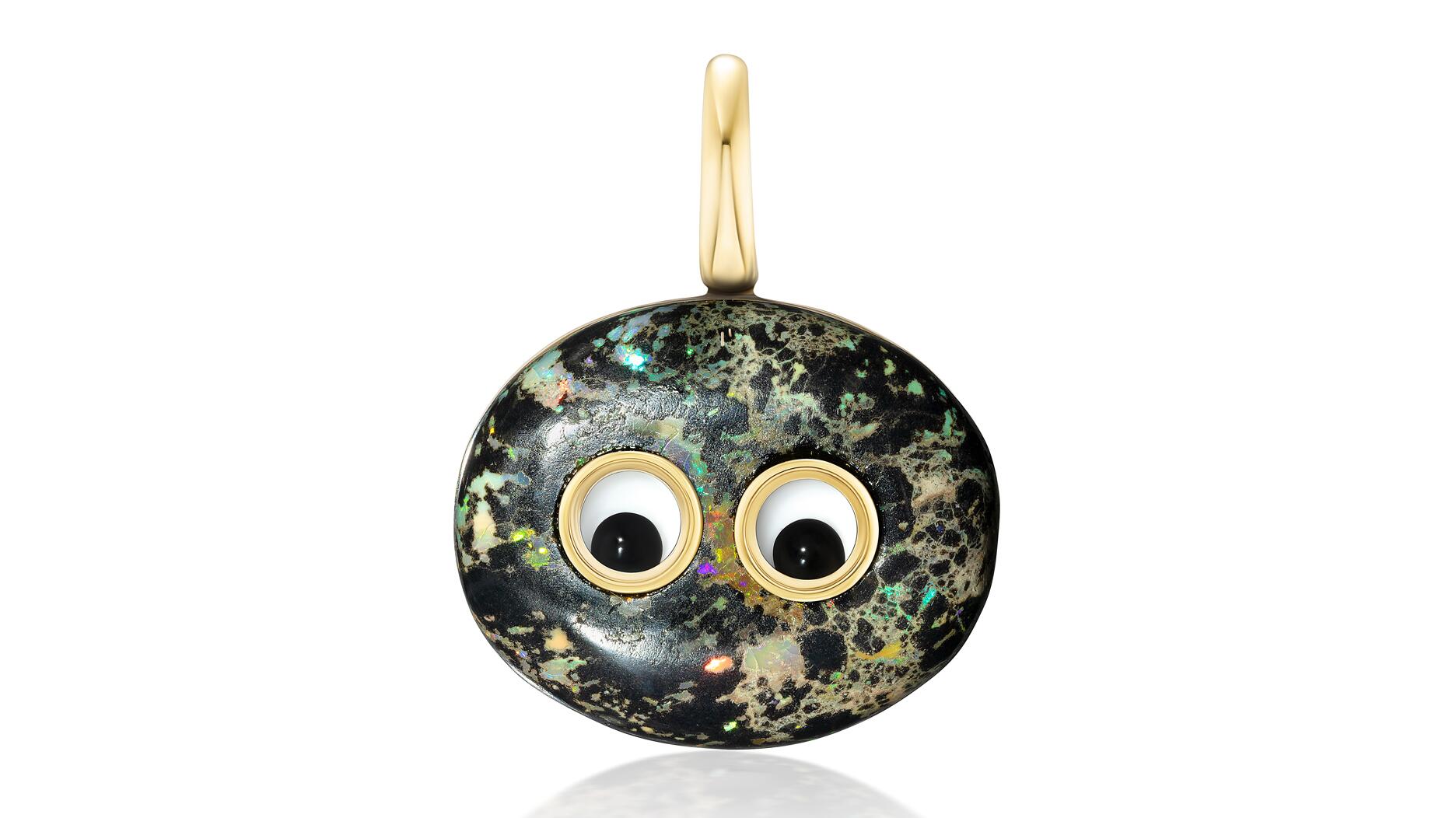The couple pleaded guilty to concealing at least $127 million in cash transactions at its precious metals businesses.
The Need Felt Globally and an Unexpected Lesson in Sales
Editor-in-Chief Michelle Graff shares three takeaways from a recent jewelry conference she attended in Istanbul.

One of my favorite quotes about traveling is one I saw drawn in chalk on the sidewalk while running in Brooklyn’s Fort Greene Park: “Never forget the pleasure of the lessons you learn while travelling.”
Sometimes, these lessons are practical in nature, such as: Definitely buy insurance went renting a car in Ireland because you’ll be driving on the “wrong” side of extremely narrow and windy roads, and the chances of damaging your car are high.
Other times, they’re more thought-provoking, like this takeaway from a recent jewelry conference I attended in Istanbul: The industry faces the same problems no matter where you go; jewelry companies around the globe feel the sting of lack of advertising, and a lot of people are struggling to adjust to a rapidly changing world.
A few more thoughts from the ASEAN Gems & Jewellery Association Conference are below, along with one lesson learned in a Turkish bazaar.
1. Not only is retail changing, but companies and employees are changing too.
Before I continue, I want to provide a little background information on the conference.
ASEAN stands for Association of Southeast Asian Nations and represents a total of 10 countries, all of which are listed on the ASEAN website. The ASEAN Gems & Jewellery Association, or AGJA, is a trade organization representing retailers, goldsmiths, colored gemstone dealers, etc., in these countries, much like JA does for jewelers in the United States.
Though I was in Istanbul for about five days, the traditional conference portion of the AGJA event was only a one-day affair, held on Oct. 9.
The most entertaining speaker of the conference, economist Emre Alkin, took the stage just before lunch and offered perspective on trade wars (news flash: they hurt the global economy) as well as his thoughts on a wide range of topics, from automation to competition in the luxury goods market to the mindset of employers and employees today.
The professor shared the slide below, an illustration credited to @tnvora showing the shift in priorities at many companies today.
They’ve migrated from being all about profit to having a purpose, and employees expect their jobs to connect and empower them. They’re not looking to be a cog in a hierarchical wheel.
“We’re not managing people, we’re not controlling people,” he said. “We’re controlling whatever they produce, the work.”
Alkin also warned the audience against pushing out younger people at their companies

In an industry once shrouded in secrecy, companies at all points in the supply pipeline are now pouring money into programs to track goods from mine to market; attend an industry conference or trade show anywhere in the world today, and the topic of “sustainability” and/or “traceability” will invariably come up.
Alkin addressed it, as did Aylin Gözen, the head of marketing and a board member of the Istanbul Chamber of Jewellery.
Alkin said: “Unless there is something [untoward] going on at your company, there is nothing to hide.”
Gözen, meanwhile, delivered the speech for World Federation of Diamond Bourses President Ernie Blom, who could not attend the conference due to health reasons, organizers said.
In his speech, as delivered by Gözen, Blom said traceability is something all companies worldwide are having to invest in, whether it’s Unilever or Levi’s. The diamond industry “will not be able to escape that trend,” he said.
As a side note, while I was in Turkey I live-tweeted a photo of another slide Alkin shared, which I’ve nominated for “Best Slide Presented at a Conference in Any Country.” But you’ll have to visit my Twitter feed to see it.
Alkin ended his speech by offering a bit of encouragement for young people working in the jewelry industry today, using this quote from “The Book of Disquiet” by Portuguese writer Fernando Pessoa: “There are ships sailing to many ports, but not a single one goes where life is not painful.”
“Do not give up on this industry,” he said. “It is a good industry.”
2. The lack of generic jewelry advertising is a problem everywhere.
“If our industry does not advertise, it will die slowly,” said Ömer Şengüler, a panelist on “Marketing Strategies for a New Generation,” moderated by Ya’akov Almor. Other panelists echoed Şengüler’s complaint, although not in terms quite so bleak.
While none of the panelists, understandably, had a solution for a problem that’s been decades in the making, both Şengüler and Almor made interesting observations about the supposed generational divide between digital and so-called traditional advertising.
“Anyone who lives in this fast-moving world has become a millennial,” Almor said to open the discussion, meaning everyone has a smartphone, is on social media, etc.; it’s not just 23- to 38-year-olds spending time online.
And Şengüler said young people do not spend all their time online, which is why advertisers still invest in billboards on college campuses and companies are trying new ways of reaching younger shoppers, like having a booth at music festival. Or, like watch brand Oris, turning an Airstream into a pop-up shop.
“We need to be mindful,” he said. “Being young does not mean being digital [only.]”
It’s also worth mentioning that in the United States, at least, an effort led by Jewelers of America is underway to launch a Got Milk?-like campaign for all jewelry.
Called “Another Piece of Your Story,” the campaign is currently in the middle of a test run in the Los Angeles-area market.
3. Bazaars are great places for lessons on salesmanship and retail display.
On the trip, I befriended a number of people from all over the world, including two goldsmiths from New Zealand, Craig Anderson and Brian Barrett. Craig is executive secretary of Jewelers & Watchmakers of New Zealand Inc. and Brian runs BHB Designs Ltd in Wellington.
Friday afternoon, the three of us spent a few hours in the Old City of Istanbul.
After taking pictures in front of the Blue Mosque and Hagia Sofia, we wandered into the Arasta Bazaar and what did I spot in the front window of the Troy Rug Store but a Pittsburgh Steelers hat, lined up among dozens of caps from sports teams from all over the globe (including, Brian and Craig noticed, a couple New Zealand rugby teams).

He explained they were either left behind or sent to him in the mail by customers. As he showed us later (after he had roped Craig into buying a rug), he has stacks upon stacks of more hats upstairs and rotates them in and out of the front window on a regular basis.
What an ingenious window display idea for a store located in the middle of the most touristy part of town. I had to wonder how many other fans of the Steelers, Cubs, Gallagher Chiefs, etc. had stopped at the sight of their favorite team’s logo and left the bazaar with a rug.
Of course, having an eye-catching window display won’t do you any good if you have terrible salespeople in your store, which the Troy Rug Store did not.
Ferdi was personable and engaging without being pushy. He also was extremely knowledgeable about the product, telling us where and how various carpets are made in Turkey as he fanned samples out on the floor.
I would have bought one of the beautiful Kilim runners he showed us upstairs, but I don’t have a long enough hallway for it anywhere in my apartment, which provided one of the final lessons from my time in Turkey: Sometimes, living in New York actually saves you money.
The Latest

Consumers shared concerns about prices, inflation, tariffs, trade, and politics in the survey’s write-in response section.

In February 2026, the auction house will move its headquarters to the former Steinway Hall, a neoclassical landmark on Billionaires’ Row.

How Jewelers of America’s 20 Under 40 are leading to ensure a brighter future for the jewelry industry.

The new show will take place Jan. 23-25, 2026.


The former BHP Billiton leader and Gemfields chairman is remembered for his influential leadership throughout his 50-year mining career.

The LVMH-owned brand has partnered with the costume design union to revamp its award for 2026.

Roseco’s 704-page catalog showcases new lab-grown diamonds, findings, tools & more—available in print or interactive digital editions.

The luxury titan inked a deal to acquire an initial minority stake in the jewelry manufacturer with a pathway to full ownership by 2032.

The company’s curation of unsigned vintage and estate jewelry debuted at the Bloomingdale’s in Costa Mesa, California.

In the recent multi-shipment seizure, CBP also found counterfeit Audemars Piguet, Moncler, and Chrome Hearts items.

Jewelers of America execs and National Jeweler editors discuss tariffs, the sky-high gold price, and the engagement that broke the internet.

The luxury goods company said founder Ippolita Rostagno will remain at the brand’s helm.

Laura Burdese, who joined the Italian luxury brand in 2022, will take on the role in July.

Need a gift for the cat lover who has everything? Look no further than our latest Piece of the Week.

It purchased the “Grosse Pièce,” an ultra-complicated Audemars Piguet pocket watch from the ‘20s, for a record-breaking price at Sotheby’s.

The lab-grown diamond grower now offers custom engagement and fashion jewelry through its Kira Custom Lab Jewelry service.

Chandler got his start at Michelson Jewelers and has served as DCA president and CEO since 2001. He will retire at the end of the month.

The boutique is slated to open this week inside Terminal 8, offering pre-owned Rolex watches and more to international travelers.

Sponsored by Digital Monitoring Products

The special-edition egg pendant ingested in a New Zealand jewelry store was recovered after a six-day wait.

Associate Editor Natalie Francisco plays favorites with Piece of the Week, selecting a standout piece of jewelry from each month of 2025.

The “Love and Desire” campaign is inspired by the magic that follows when one’s heart leads the way, said the brand.

Two awardees will receive free tuition for an educational course at the Swiss lab, with flights and lodging included.

Berta de Pablos-Barbier will replace Alexander Lacik at the start of January, two months earlier than expected.

Sotheby’s held its first two jewelry sales at the Breuer building last week, and they totaled nearly $44 million.

Winners will receive free registration and lodging for its fourth annual event in Detroit.


























